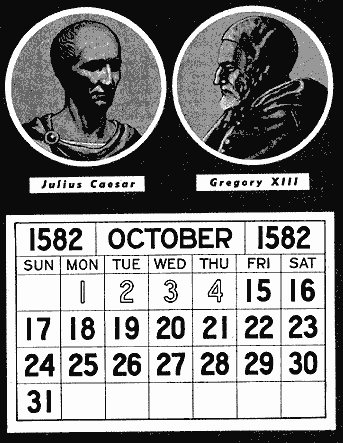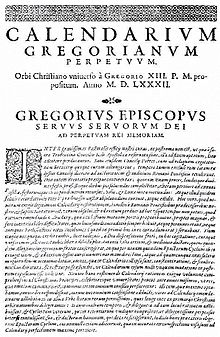For a large part of European history, people tracked the days, months, and years using the Julian Calendar, named for Julius Caesar, who introduced the concept in 46 B.C. People gradually discovered, however, that this calendar wasn’t as accurate as it needed to be to reflect truly the passage of time, as marked by the orbit of Earth around the Sun.
In the late 16th Century, demand for a change to the calendar had grown strong.
 Scientists discovered that the Julian Calendar introduced an error of one entire day every 128 years. Part of the problem was the way in which the Julian Calendar calculated a Leap Year. If a year could be divided by 4, then that year was considered to be a Leap Year. (A Leap Year was necessary because Earth’s orbit isn’t exactly 365 days.)
Scientists discovered that the Julian Calendar introduced an error of one entire day every 128 years. Part of the problem was the way in which the Julian Calendar calculated a Leap Year. If a year could be divided by 4, then that year was considered to be a Leap Year. (A Leap Year was necessary because Earth’s orbit isn’t exactly 365 days.)
Another prime motivation for the switch was a religious one. Major officials in the Catholic Church wanted to match the date on which the Christian holiday of Easter was celebrated with the spring equinox. Under the Julian Calendar, Easter, which was traditionally observed on March 21, was further away from the spring equinox as time went by.
So the leader of the Catholic Church at the time, Pope Gregory XIII, determined that a change should be made. The result was the Gregorian Calendar.
The crafters of the Gregorian Calendar introduced a more sophisticated set of rules to deal with Leap Years. As with the Julian Calendar, the year must be divisible by 4. But if that year can be evenly divided by 100 as well, it is not a Leap Year, unless it can also be divided evenly by 400.
As a result, the Gregorian Calendar will be off by an entire day only every 3,326 years.
The length of a year on the Julian Calendar was 365 days, 6 hours. The length of a year on the Gregorian Calendar is 365 days, 5 hours, 49 minutes, 12 seconds. To implement the change, Church officials effectively removed 10 days from the calendar.
 So the decree of Pope Gregory XIII went into effect on October 4, 1582, a Thursday. The next day, marking the advent of the Gregorian Calendar, was October 15.
So the decree of Pope Gregory XIII went into effect on October 4, 1582, a Thursday. The next day, marking the advent of the Gregorian Calendar, was October 15.
As well, the proclamation that announced this new calendar set a date range for Easter: between March 22 and April 25, after the first Full Moon that occurs after March 20.
Right away, Italy, the Netherlands, Poland, Portugal, Spain, and most areas of France adopted the Gregorian Calendar. Austria and the Catholic states of Germany followed a year later, Switzerland followed two years later, and Hungary did so four years after that. Prussia switched in 1610. Denmark, Iceland, and Norway followed in 1700.
It is important to note that some of these countries were divided along religious and political lines for a great many years. The parts of countries controlled by Catholic rulers switched relatively straight away; Protestant-controlled parts of some countries took much longer to make the switch.
It took other countries longer altogether. Great Britain adopted the Gregorian Calendar in 1752. (This included all territories then ruled by Great Britain, including large parts of what is now Canada and the United States.) By then, the disparity between the two calendars had widened and so British peoples removed 11 days from their calendars.
Sweden (which also included Finland at that time) switched in 1753.
By the time that Japan (1873) and Egypt (1875) switched, the people in those countries had to wipe out 13 days.
That was the highest number of days required. The remaining countries to switch did so in the 20th Century: China in 1911, Albania in 1912, Bulgaria in 1915, the Baltic States and Russia in 1918, Romania and Yugoslavia in 1919, Greece in 1923, and Turkey in 1927.
Because not all countries had switched, people in Great Britain (who didn’t switch until 1752) were celebrating 1700 as a Leap Year when their French and German counterparts (who switched in 1582, 1583, and 1610) were not.
One oddity about the British change to the Gregorian Calendar is that the year it went into effect, 1752, was the first year for which the calendar began with January 1 for many a year. The Julian Calendar set the year to begin on January 1, but many European countries in the Middle Ages set different days for the year to start. Some countries decided that their new year began on Christmas, December 25. Other countries chose September 1, for non-religious reasons.
Another religious holiday, the Feast of the Annunciation, took place on March 25, and it was on this day (known as Lady Day, for Christianity’s Virgin Mary) that the new year began in Great Britain, starting in the 12th Century and lasting until 1752.
In that year, the people under British rule went to sleep on September 2 and woke up the next day to discover that it was September 14.